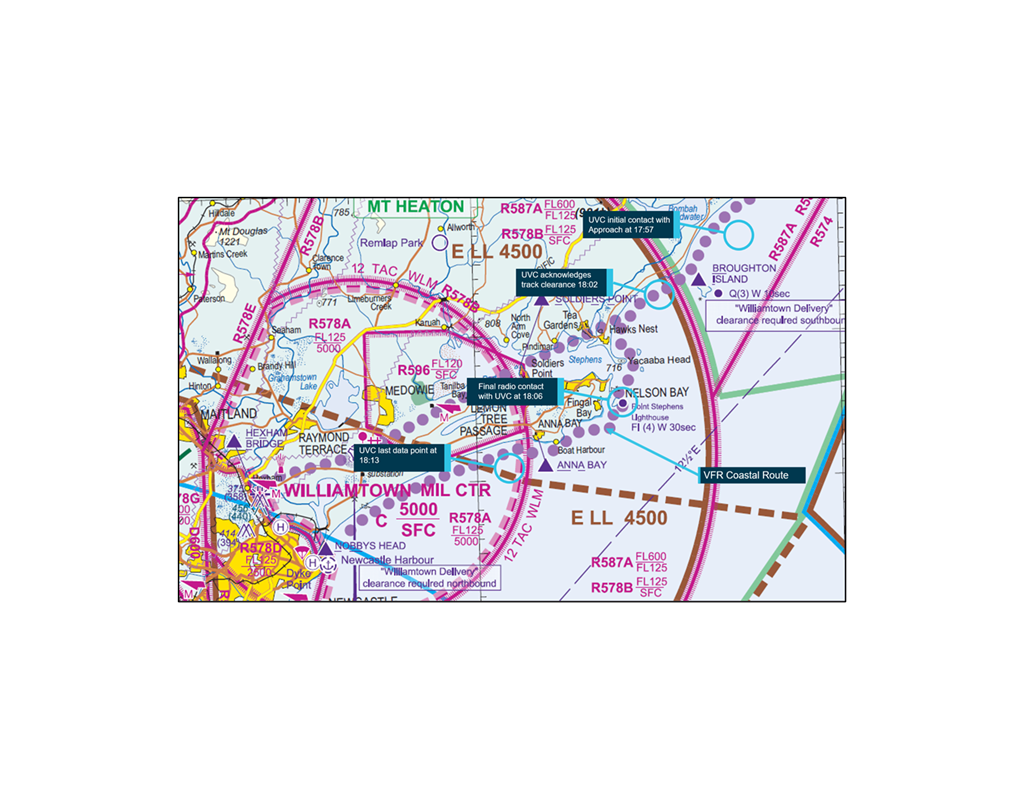
The collision with water of a Bell UH-1H helicopter near Anna Bay, NSW, resulting in the loss of all five people on board, highlights the significant risk of visual pilots attempting to fly in instrument conditions, the Australian Transport Safety Bureau (ATSB) investigation into the Sep. 6, 2019, accident notes.
The pilot of the UH-1H likely became spatially disorientated and lost control of the helicopter while flying in dark night conditions, the investigation found. Published last light for Anna Bay was 6:01pm, with recorded data showing that the helicopter made a rapidly descending left turn and collided with water at about 6.13pm.
Wreckage of the helicopter was subsequently located in about 30 meters of water, approximately 5 kilometers south-west of Anna Bay, almost three weeks after the accident.
The pilot was only qualified to fly by day under the Visual Flight Rules – VFR – and so was not trained or experienced in maintaining control of the helicopter with sole reference to the flight instruments, the investigation notes.
“The ATSB found that the pilot continued to fly after last light without the appropriate training and qualifications, and then into dark night conditions that provided no visual cues. That significantly reduced the pilot’s ability to maintain control of the helicopter, which was not equipped for night flight,” said ATSB Chief Commissioner Greg Hood.
“Once visual references were lost, the pilot likely became spatially disorientated and lost control of the helicopter, resulting in a collision with water.”
The helicopter had departed from Brisbane’s Archerfield Airport on a repositioning flight to Bankstown Airport, in Sydney. After refueling at Coffs Harbour Airport, the helicopter then departed for Bankstown at 4.48pm, which the investigation determined would have left insufficient time for the helicopter to safely reach its destination before the published last light.
As the flight passed the halfway point and progressed closer to the destination, the pilot may have become increasingly committed to continuing with the original plan.
Consequently, deciding to turn back or divert may have been perceived as increasingly difficult, the investigation notes.
“A pilot’s decision to continue their flight when faced with reducing visual cues may be influenced by self-induced pressure to complete their flight,” Mr. Hood said.
Air traffic control (ATC) from the nearby Williamtown Royal Australian Air Force Base had made several radio calls with the helicopter prior to the accident, assisting the pilot with requested altitude changes. During one exchange, the pilot commented to ATC about the turbulent conditions they were experiencing. The controller acknowledged the conditions and made a further offer of assistance should it be required.
Visual cues may have been available to the pilot from ground‑based lighting close to the aircraft’s track as the flight progressed after last light. However, at 6.11pm the helicopter commenced a left turn and departed the VFR coastal route and tracked offshore on what appeared to be a direct track to Bankstown.
As the helicopter flew over a featureless sea with overcast conditions blocking out celestial lighting, the pilot likely lost any remaining visual cues and encountered dark night conditions. Williamtown ATC radar contact with the helicopter was lost about two minutes later.
“Research has shown that pilots not proficient in maintaining control of a helicopter with sole reference to flight instruments will become spatially disorientated and lose control within one to three minutes after visual cues are lost,” Hood said.
“A VFR flight in dark night conditions should only be conducted by a pilot with instrument flying proficiency as there is a significant risk of losing control if attempting to fly visually in such conditions.
“If day VFR‑rated pilots find themselves in a situation where last light is likely to occur before the planned destination is reached, a diversion or precautionary landing is almost certainly the safest option, or ATC may be able to provide assistance with available landing options.”
The investigation also found that the pilot, who was under the care of a non-aviation medical specialist, did not disclose on-going medical treatment for significant health issues to the Civil Aviation Safety Authority (CASA). While not considered to be a contributing factor to the accident, this non-disclosure prevented specialist consideration and management of the ongoing flight safety risk the medical conditions and prescribed medications posed.
“This tragic accident also highlights the importance of aviation medical certificate holders reporting relevant conditions and medications to their Designated Aviation Medical Examiner,” Hood said.
“Pathways exist for managing certain medical conditions that do not preclude a pilot from maintaining an aviation medical certificate.”
This press release was prepared and distributed by the Australian Transport Safety Bureau.



